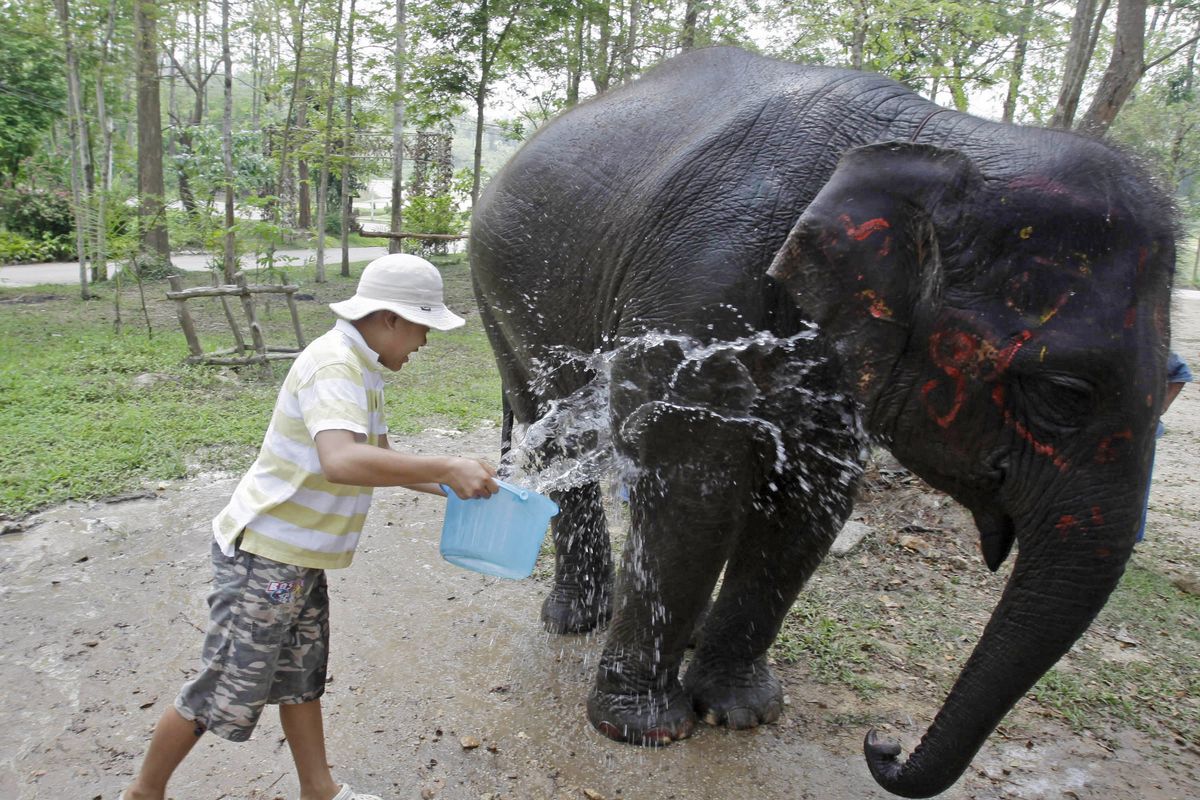Thailand elephants’ new role: Helping autistic kids

LAMPANG, Thailand — Kuk-kik, a 14-year-old boy, punctuates his few, slurred words with yelps. Kong screams and bites his fingers when he can’t figure out how much to pay for bananas. Other children freeze mid-motion, fix their gazes on minute objects and withdraw.
Enter Nua Un and Prathida — two gentle, lively and clever female elephants — and the mood among the autistic teenagers in Thailand changes as they begin their therapy, the world’s first using these charismatic animals.
They scrub and soap their bristly hides, play ball games with the well-trained pachyderms and ride them bareback, smiling.
“Chang, chang (Elephant, elephant). Children, have you ever seen an elephant?” the group sings, clapping hands to the traditional Thai nursery tune and hugging the elephants’ trunks. Disco-like, Nua Un bobs her head and sways.
Everyone cheers in a rousing climax to another day in this program in the forests of northern Thailand, which seeks to help autistic children through interaction with elephants.
Animal therapy for people with developmental disabilities — notably using dolphins, dogs and horses — is not new, and has provoked skepticism — especially in connection with expensive swimming-with-dolphins programs. But some anecdotal evidence and studies have shown positive results.
Wittaya Khem-nguad, the elephant project’s founder, says parents “see improvements after the elephant therapy and that gives them this hope.”
A small preliminary observation found improvements among four boys after three weeks of elephant therapy, but more research with larger samples is needed, says Rebecca Johnson, who heads the Research Center for Human Animal Interaction at the University of Missouri. A presentation on the Thai program was recently made at the school’s Thompson Center for Autism and Neurodevelopmental Disorders.
Autism is incurable but therapy and medication can improve speech, learning and social problems, and reduce behavior like tantrums.
Elephants have lost their traditional roles in Thailand as trucks, teak loggers, and battle tanks, Wittaya, who gave up a career in advertising to work with elephants, started the project as a way to help the endangered animals regain their usefulness. After reading about horse riding therapy, he approached Chiang Mai University, where Nuntanee Satiansukpong, head of its occupational therapy department, suggested elephants might help those with autism.
Elephants, she says, provide the rich, attention-grabbing “sensory menu” beneficial to the autistic, while the animals’ intelligence and other traits allow for a wide range of interactions with humans. Additionally, elephants are woven into the fabric of Thai culture, familiar to children since birth.
Nuntanee worked out six key activities for the therapy sessions with her staff. Then they went to the government-run Thai Elephant Conservation Center near the northern city of Lampang, where the sessions take place in a forested clearing.
Each activity is designed to improve specific skills. The children learn to follow step-by-step instructions by drawing up shopping lists and buying food for the elephants — bananas, sugar cane, corn, sunflower seeds — at a mock store with real money. If the elephant rejects the food, they return to the store for an alternative, which teaches flexibility. Feeding the animals and brushing 7-year-old Nua Un when she obligingly lies on her side for a bath can help the kids overcome an aversion to sticky and rough textures.
Playing games, with the elephants kicking and offering balls with their trunks, fosters group activities. Riding, besides sheer fun, requires specific sequences of mounting and commanding while addressing poor balance and posture. And elephant-themed art activities — painting and making mobiles, paper lanterns and mosaics — spark the imagination.
“The elephant is such a big stimulus it can keep the attention of an individual longer, and since it is such a wonderful animal bonding can occur,” says Nuntanee. “If we can drag the children out of their own world they will be better,” she says.
But throughout the day, some of the participants regress. Kuk-kik Kraisiri refuses to take part in a game, abruptly squatting down to bang two stones together and poke the earth with a stick. Kong Jatjeeng erupts in screams after a stray brush stroke. A third teen tears his paper lantern to shreds because he cannot puncture holes for stringing it up, then sobs.
The parents, who accompany their children to the elephant center, have asked for the free therapy to be continuous, but Nuntanee says that with limited funding, only eight-day sessions are offered.
Kuk-kik’s mother Saithong says her son doesn’t usually “join activities with other people. He would be by himself. This is the first time he is not.”
Kong’s mother Keesorn said the therapy helps make her son more patient, gentler and willing to share. But she added: “His mood changes every day. He lives in his own world. We will have to take care of him for the rest of our lives.”